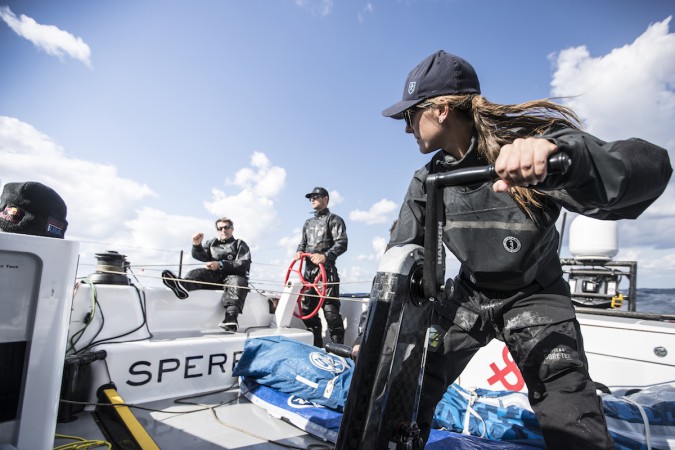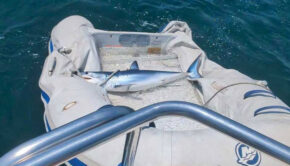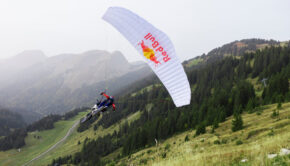Crazy Adventures at Sea
Published on November 17th, 2016
Through the wonders of athlete sponsorship, and the history of Red Bull promoting all forms of crazy adventures for marketing lore, the backing of the energy drink company to test the 46-foot F4 foiling catamaran’s offshore ability was pure Madison Avenue.
Joined by Red Bull Sailing Team member Jimmy Spithill (playing hooky from America’s Cup duties?), the mission was to sail the 660 nautical mile route from New York City to Bermuda. Emily Nagel was a member of the six-person crew…here’s her report:
Sailing has been a part of my life since I was 10 years old. Having grown up in Bermuda as a sailor, and having sailed in the Red Bull Youth America’s Cup, I was blown away when it was announced that the 35th America’s Cup Challenger Match would be hosted on my little rock of an island.
My excitement was amplified even further when few months ago, I was approached out of the blue by Red Bull with the opportunity to foil offshore on a mission of epic proportions alongside America’s Cup sailor Jimmy Spithill – one of my role models and one of sailing’s most accomplished athletes. The plan: to sail a foiling catamaran with a team of six crew members across the 660 nautical mile stretch between New York City and Bermuda.
Although America’s Cup boats like the AC45 and AC72 have foiled in races for a few years now, no sailor has ever foiled on an offshore course of this length; which is why the idea of sailing 660 nautical miles from New York to Bermuda is one that struck me as insane. Although the mission was ambitious, the prospect of being one of the first sailors to accomplish this goal pushed me to accept without hesitating.
The mission began with two training weekends in Newport, RI and New York City. These weekends provided the perfect opportunity to get to know the team and the F4 – the boat designed specifically for this mission to explore the possibilities of offshore foiling.
As an engineer and naval architect, the entire concept behind the Flying On Water mission was exciting. I had the opportunity to see firsthand how foiling technology has developed over recent years, and it was evident that foiling has brought a whole new dimension to the sport of sailing.
After completing two weeks of training, we were on constant standby as we waited for the perfect weather system to come through. I spent much of this time training with TeamBDA, Bermuda’s entry for the 2017 Red Bull Youth America’s Cup, and I was out on the water when Red Bull green lighted the project. Three hours later, I was on a plane with Jimmy Spithill and Rome Kirby with a one-way ticket.
The morning after our flight, the crew met at 7AM to prep the boat, get briefed on safety, chart our course, and set off. Soon after, on November 5th, the New York City skyline shrank behind us as we sailed out into the Atlantic to do what no sailor had ever done before.
Prior to the mission, my experience in offshore sailing was extremely limited, to put things lightly. And by extremely limited, I mean to say that I had only sailed offshore once on the Irish Sea a couple of years ago…
Despite my lack of experience offshore, the team’s collective experience as a whole took the mission to the next level. Onboard our F4 foiling catamaran were five of the best sailors in the world: America’s Cup athletes Jimmy Spithill, Rome Kirby, and Shannon Falcone, world-class Moth sailor Tommy Loughborough, and Olympian Cy Thompson. Each member of the team brought along an incredible amount of experience. But still, the task we faced was daunting, and we quickly learned that we had quite an adventure ahead of us.
The first day on Saturday was glamour. We had perfect conditions for foiling and covered an incredible amount of distance, foiling for most of it. Once out of New York, the guys handed the helm over to me, and I was allowed to try my hand at helming the incredible F4. I have been lucky enough over the past few months to sail other foiling boats such as my moth and Team BDA’s GC32, but it was rather surreal to be coached to helm the F4 with Jimmy and the others.
Sailing through the night, we were each put on watch: four hours on and four hours off each night. During the first day, I found it hard to settle into the routine. I was far too excited about the mission and could not bring myself to go down below and sleep.
When the sun set on our first evening, I think everyone was in awe. We had the most incredible sunset and then a completely clear sky. We were foiling into the dark at 20 knots with stars all above. There was even enough moonlight to see the puffs of wind on the water; yet again, foiling at night presented another new experience for me.
My watchmate for the trip was Tommy, and over the three days he taught me an incredible amount about offshore sailing. We were on the graveyard shift on the first night when suddenly the weather began to turn.
The sea state gradually worsened and the wind picked up as our crewmates slept in the cabins below. There were a few moments where I started to get nervous, but I didn’t admit it to Tommy at the time. My imagination has a habit of getting carried away, and at this moment in time, I began to worry. Despite my racing mind, the rest of the crew stayed calm, giving me the confidence to wash any worries away.
Over the next two days, the weather continued to worsen. We thought that once we crossed the Gulf Stream that the sea state would calm down. That never happened. By Monday evening, we were sailing with just a stay sail through six meter high waves, on average. Some of the waves we saw we estimated to be nearly 10 meters tall. (To put that in perspective, imagine a three story tall house floating towards you.)
When that much water is coming towards you, you really have to focus to stay calm and keep the boat under control. On the first day, we had damaged one of the board systems and we were constantly at full rake, which created lift that made the boat want to foil. While this might increase your speeds, if you are going down a wave of this size with another wave coming straight ahead, you don’t want to be foiling! Doing so could lead to a massive nosedive – possibly to a capsize. Unlike a monohull, if a catamaran capsizes, it won’t come back upright.
Given the obvious danger, our crew tried everything we could to slow the boat down as much as possible to stop ourselves from crashing into the wave in front.
This lead to an insane final evening. We actually got used to the waves after a short while as the sun set. I was up on deck with Shannon and Tommy, surfing down waves and enjoying a dance party as music from our waterproof speakers blared onboard. It was when we handed the watch over to Rome and Cy that things got even more interesting.
The sea state once again became more agitated and confused, sending our F4 into a number of nosedives. Facing a dangerous situation, we decided to take down the last remaining sail to slow the boat down. With our last sail down and nothing but bare poles, we sailed the final 50 nautical miles to Bermuda at decent pace purely on wave power.
Ahead on the horizon, we looked out to see the lighthouse on the point – the very same lighthouse that I live next door to. We were home.
When we arrived in Bermuda, it was 2AM; we were functioning on minimal sleep; we hadn’t showered in three days; and my hair had turned into a dreadlock – not to mention we had run out of food and water earlier that day. (Small miscalculation; Rome eats a lot.)
Despite all that, I was elated. We had made it.
At the end of the trip, I am proud to say that I was never seasick, I never freaked out, and I loved every minute of the journey. It was the craziest adventure, and I would do it again in a heartbeat. I’m thinking now is the perfect time to find out whether there are any open spots for the Volvo Ocean Race!
Source: Sperry











 We’ll keep your information safe.
We’ll keep your information safe.